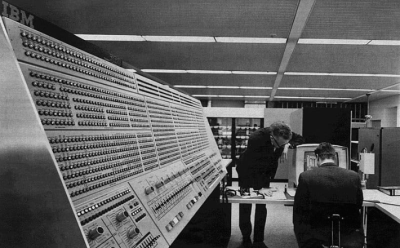
In the 1950’s, the newspaper was filled with stories of the coming computer age, many of them written by futurists and Science Fiction authors like Isaac Asimov. Some articles predicted massive unemployment and human obsolescence while others foretold the coming of a golden age of productivity and leisure. Many of these predictions where remarkably accurate while many more were wildly off the mark.
For the residents of Council Bluffs, what once sounded like a distant Science Fiction, was becoming a reality as the community steadily adopted new computer systems.
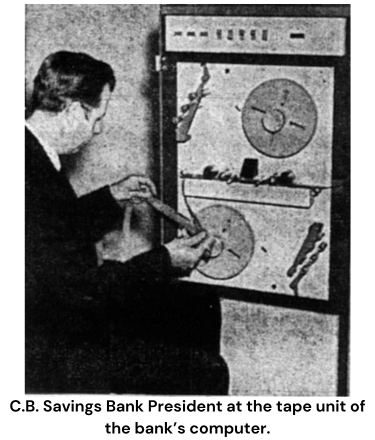
One of the first computers in Council Bluffs was installed at the Union Pacific Railroad yard offices in 1954. This machine, and others like it in North Platte and Cheyenne yard offices, performed automatic switching and speed control to minimize impact damage to boxcars. A newspaper story on the new system referred to it as the “Electronic Wizard.”
Also among the first to realize the benefits of computers, were the local tax collectors. The Pottawattamie County Board of Supervisors authorized the purchase of a $12,000 computer for calculating and billing taxes in 1962. Unlike today’s office computers, computers of the era were massive, often filling entire rooms. The County’s first computer, purchased from the Burroughs Corporation (a competitor of IBM,) was expected to “cut the volume of work in half.” Six years later, the Board of Supervisors approved the purchase and lease of additional accounting computer and additional data processing services. These early tax calculating computers were useful, but not infallible. A newspaper editorial published under the headline, “The Computer’s Cheating Us,” alleged that computer systems caused Pottawattamie County school districts to lose out on thousands of dollars in taxes.
In 1964, the Iowa Highway Commission was considering a number of proposed road projects in and around Council Bluffs. To determine which projects to undertake, the Commission needed accurate data on traffic volume throughout the city. For two weeks, vehicles coming into Council Bluffs where stopped and the drivers were asked about their daily travel routines. Their responses was encoded on punch cards which were later fed into a computer were the presence or absence of holes in certain areas indicated to the computer how to tally the data. A spokesman for the Commission said it would take the “ultra-fast” computer up to one and half years to tabulate the results.
That same year, staff from Abraham Lincoln and Thomas Jefferson High Schools were trained on how to use computers at the Iowa Educational Information Center in Iowa City. The School District hoped that using a computer would speed up the process of scheduling classes. Confused students lined up outside of the principal’s office on the first day of school in 1965. Their computer-generated schedule cards, which should have indicated they were dismissed from a period, instead contained the number 202 (the principal’s office, where the dismissal was authorized). About 500 students interpreted this as meaning they were to report to the principal’s office for class. Two boys were assigned to a girl-only physical education class at Thomas Jefferson, and one a student with no musical experience was assigned to play in the Tee Jay band. The bugs were worked out by the following year, which administrators happily considered “the most uneventful” start to a school year in recent memory.
One of the first businesses in Council Bluffs to recognize the potential of computers was Council Bluffs Savings Bank. In 1965, the bank, which was founded by John Baldwin and General Dodge, was over 100 years old. The newly arrived machine was introduced to staff at the office Christmas party where the head of the bank’s computer department had programmed it to click the rhythm of Christmas songs and to print pictures of Santa Clause. The Council Bluffs Savings Bank computer consisted of master control, five magnetic tap handling machines, and a variety of printers and readers. It was capable of processing 750 items per minute, and, according to one manager, could do in two hours, “the amount of work that three girls turned out in an eight hour day.” The computer required a staff of six to run at full capacity.
While it was a banner year for the Bank, which viewed computers as a way to grow business, some in the community were anxious about the change it represented, and other businesses sought to capitalize on their unease. A 1966 advertisement for a local accounting service warned, “this year, an IRS computer will check your income tax return … Play it safe …. Don’t take any chances.”
The Bank loaned computer access to others in the community, including the School District which, having successfully used computers to prepare schedules, began using computers to record and report grades and attendance. In addition to scores, teachers could select from one of 5 canned comments concerning the students’ progress (i.e. “Contributes to class activities”). The machine could not accept individual comments, and teachers complained that the available phrases did not always suit the situation.
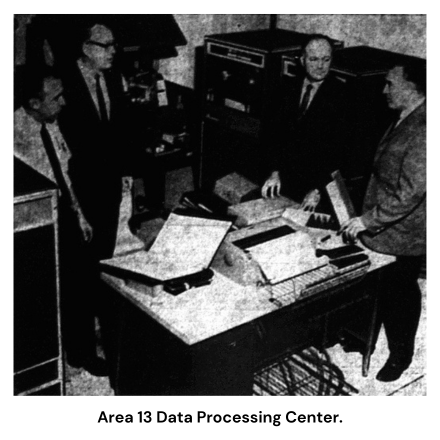
By the end of the 1960’s, many local businesses could see the benefits of computers, but few could afford the investment. With that in mind, local businessmen sought to make a computer service center to provide automated information control systems for businesses, industries, institutions, and governments to whom they would charge an annual rate of $100,000. While some in business hoped to make money by loaning computer use, educators envisioned a shared seven-county-wide data processing system schools. And others, like the Metropolitan Life Insurance Co. office in Council Bluffs, connected remotely to computers in New York using a “teleprinter” dummy terminals.
As schools got access to computers, students had no difficulty thinking of ways to have fun with them. A local fad of “Computer Dances” took place at Harlan, Tee Jay, Lewis Central, and Saint Albert’s High Schools. Gyms were decorated with Christmas lights and cardboard boxes which imitated the boxy, blinking cabinet computers of the day. Typically, each student admitted to dance was given an IBM punch card and a number to wear. The punch card was filled with questions about personality traits, likes and dislikes, favorite activities, etc. Once filled, the cards were fed into a computer which paired students based on their “compatibility score,” sort of like a prototypical OkCupid. Some students admitted to cheating by lying on their cards in hopes of getting paired with preferred partners. Other students took a more fatalistic view; “If I get paired with someone weird,” one student mused, “I guess that means I’m weird.”
In 1967, Pottawattamie legislators agreed to let a computer draw sub-districting maps. The County’s voter registration rolls were fed into a University of Iowa computer, which split up the county into equally proportioned districts. Local party leaders agreed that this would be a fair way to draw maps that would be free of partisan gerrymandering. However, when they got the results back, neither party was pleased. Issuing scathing remarks about “idiot computers,” the rival parties were united across party lines in their opposition to the computer.
The Council Bluffs Police Department began using computers in 1968 when a Metropolitan Area Planning Commission (MAPA) computer was connected to a National Crime Information Center (NCIC) database in Washington DC. With this new database, created by FBI director J. Edgar Hoover, Officers could submit names and license plate numbers a receive records back in 12 seconds. The local paper published many articles about the department thwarting criminals with this new system. The system, however, was not infallible. When police ran plates of an apparently abandoned car, the NCIC quickly reported back that the vehicle was stolen. Later, when a man came to complain that his car had been towed, the Police Department learned that the legally owned car happened to have the same license plate number as a stolen car in Kansas, and the system did not distinguish between the two. The Police Chief later admitted that the mix-up could have resulted from user error, but decided, “We’ll just blame it on the computer; that way no one will be hurt.”
When Mercy Hospital began construction on a new five-story addition in 1968, every item used in the construction project and the date of use was programmed in advanced by a computer to control costs and schedules. When the Hospital later received computers of its own, some on staff used it to brag to their peers. The hospital sent a sort of email to a terminal in Peoria, Illinois announcing that a Council Bluffs basketball team had defeated a Peoria team in a high school tournament. They received back a congratulations from another terminal in Georgia. The computer sent another message, saying “hi” to staff and intruding itself to staff as “Big Mac” (a name chosen via an employee contest). No doubt, instant email seemed fun … for a while.
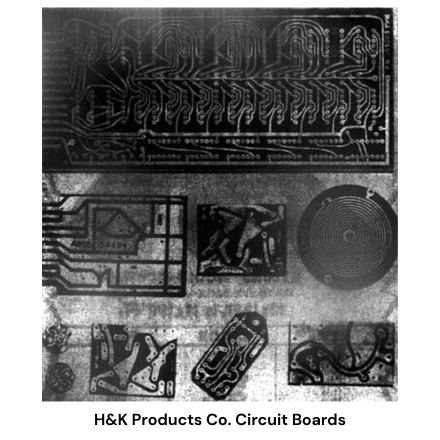
A Council Bluffs entrepreneur named Clarence Huntley, who started out tinkering with electronics in a chicken shed as a boy, was named Iowa Small Businessman of the Year in 1969. His company made custom solid-state circuit boards for major manufactures of computers, appliances, airplanes, musical equipment, and atomic energy. As a custom shop, the company received some pretty interesting commissions, one of them from conservationists seeking to track salmon who contracted with the company to make a mini-broadcasting system that could be attached to the fish as they headed to sea.
In 1969, The Iowa Power and Light Company built a five foot diameter cone on top of Hotel Chieftain, known as “the black thing.” The cone, part of a $3.5 million communication network, was a micro-wave radio transmitter that could send teletype messages to a computer in Des Moines.
By the end of the 1960’s, the local paper was filled with job advertisements for computer operators. It became apparent that, in the near future, computer skills would be a necessary component of education. Schools screened videos about computer languages, science fair entries showcased home-made computers, and music classes explored Moog synthesizers. With this future in mind, the Pottawattamie County Board of Education bought a computer and opened the Area 13 Educational Data Processing Center. The computer was housed at the new Iowa Western Community College campus. In addition to being used by County educators, the computer was used to teach programming and data processing.
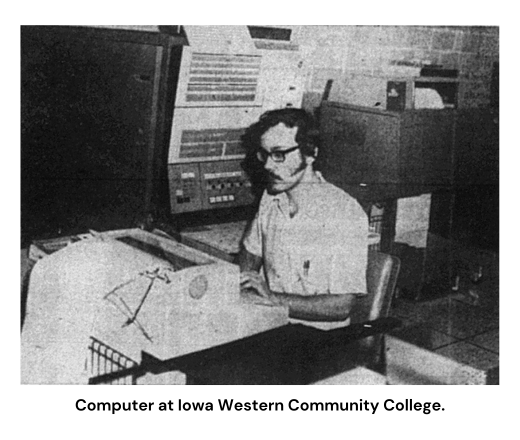
Because systems were expensive (costing tens or hundreds of thousands of dollars), taxpayers sometimes objected when government services were computerized. The Board of Education got pushback for purchasing data processing services instead of using the computers at Iowa Western. Some insisted that agencies should be forced to work together because, “the taxpayers are suffering enough … [and] can’t afford the luxury of such independence.”
When the Northwestern Bell Telephone Company opened its new office on Kanesville Boulevard in 1970, the 2.7 million dollar building housed 5.2 million dollars in computer equipment. The computerized switching system consisted of 260 units, each of them seven feet tall. The computer checked 42,000 phones every tenth of a second. The police liked the new system, which included a computerized line identification machine – basically caller id.
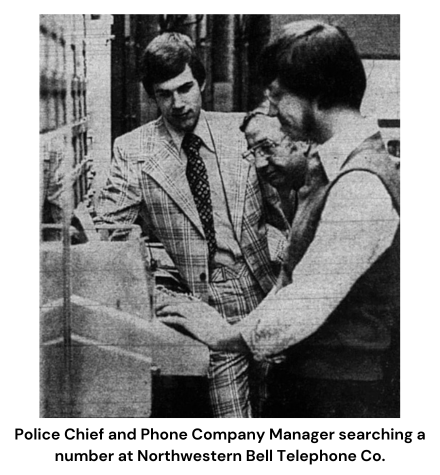
But businesses and municipalities were not the only ones to recognize the potential of computers. Scamming and phishing were a part of story of computers from the very beginning, as elderly residents of Council Bluffs received calls from criminals who sought to capitalize on the fear of people who mistrusted computers. One caller, pretending to be with a local bank, claimed that something was wrong with the bank computer, but he just couldn’t figure it out. He asked them to empty their accounts and (to make sure the computer had tallied correctly) he would personally count and deposit the money. Computers also aided the operations of spammers as the distributers of junk mail were able to “personally” address letters and facsimile checks.
The Metropolitan Area Planning Agency (MAPA) used computers to conduct another survey in 1970 – this time about population, commercial, and industrial projections. The computer predicted that Sarpy County would outstrip Pottawattamie County in all categories by 1995. One person on the City Council refused to believe the results, which showed commercial growth bulging in a westward direction instead of east into Pottawattamie County. It turns out the computer’s predictions were too conservative – by 1985, Sarpy County had outgrown Pottawattamie.
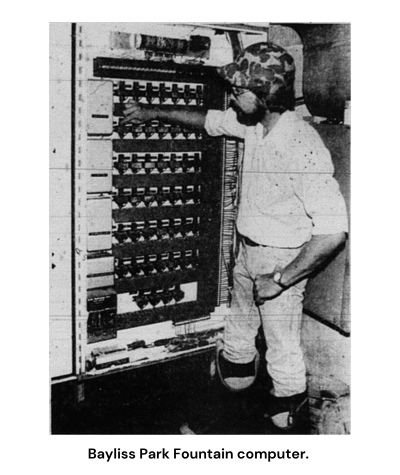
The Bayliss Park Fountain was updated in the 1970’s to include bright lights, changed lights and cycling water jets. These new hi-tech new features were controlled by a computer in an underground vault near the fountain. The computer sent signals to a motor (also in the vault) to control the different patterns and heights of the water streams. The system was impressive, but not perfect. One newspaper editorial said, “We’ll admit we’re ignorant of how the fountain display in Bayliss Park is programmed… Earlier this year, we sat for nearly an hour watching the splashing water and eerie lights. Lately, however, the program seems to have large gaps – sort of like a bad stage production with not enough rehearsal.”
By the end of the 1970’s, computers were becoming a more common sight in offices of every type. And as they became more common, they became less exciting. While the newspaper once wrote lengthy articles about computers, new systems were now mentioned briefly if at all. The city installed computerized traffic lights, voter registration was computerized, the new bowling alley had automatic scoring, the library could download catalog records from Ohio, the hospitals could recall microfilmed medical records “at the push of a button,” the newspaper went to computerized typesetting, the new JCPenny store had computer cash registers, water bills were generated by a computer, and the urban renewal project was managed by a computer. Really, the only time computers made headlines were when something went wrong, like in 1977 when some Council Bluffs residents received $30,000 electric bills - the result of a mistake in the computerized billing system.
By the end of the decade, the newspaper was printing ads for home computers. The local Radioshack advertised a “complete computer system for your child’s future.” JCPenny and Skaggs advertised the “Atari Video Game Computer” as the must-have Christmas gift. In 1980, Council Bluffs high schools purchased Apple II personal computers (remember Oregon Trail?), and a store called Computer Town opened at the old mall.
It seemed that the days of giant, room-sized computers was ending. New systems were much smaller and much cheaper, and many people were predicting a future with computers on every desk, or even in every pocket. However, not everyone believed these predictions. One editorial in the Nonpareil said, “When it comes to information retrieval I doubt if there really is the market out there that home computer manufacturers think there is. The American wife has a memory far superior to any computer.” Meanwhile, somewhere in Switzerland, someone was working on a thing called the “World Wide Web.” That probably wasn’t going to amount to anything either.
Click HERE for more information on Council Bluffs History.